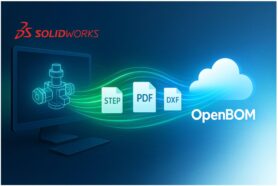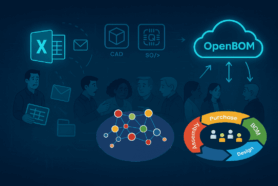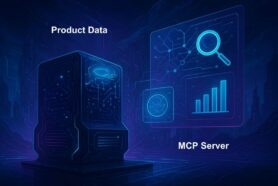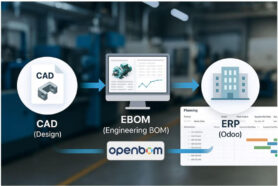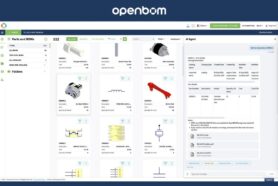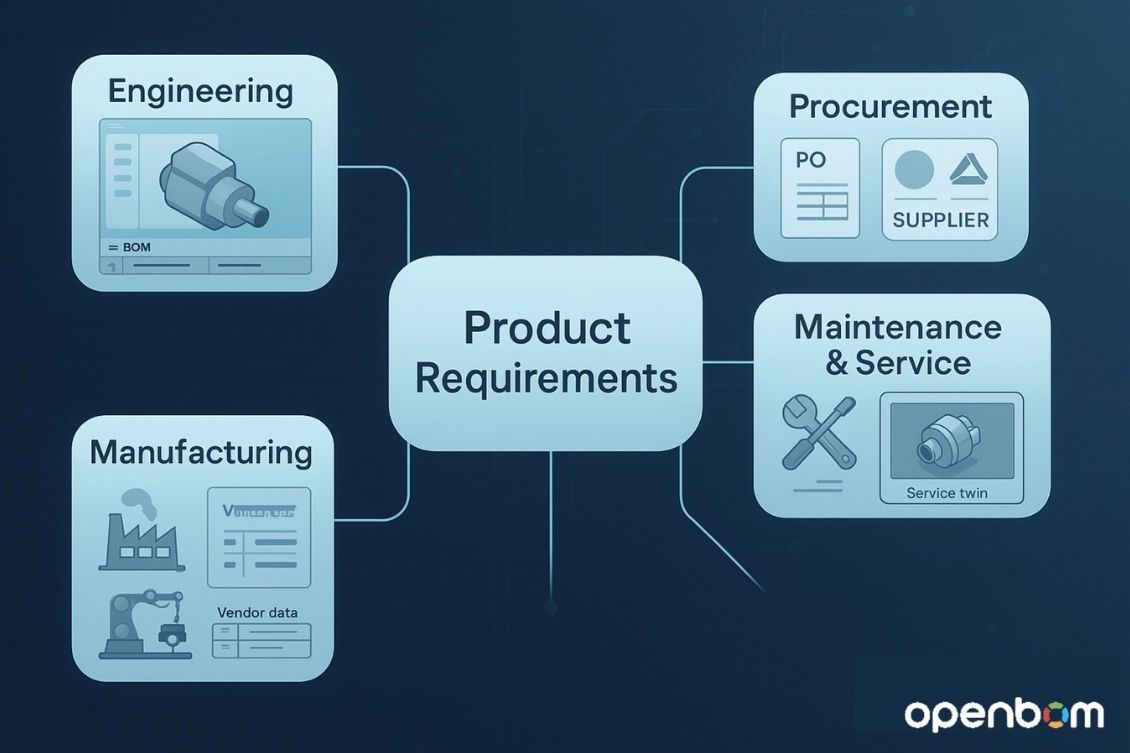
Requirements management with OpenBOM xBOM connects specifications to every stage of the product development lifecycle, from product design to procurement to maintenance, through a unified digital thread.
Let’s face it, requirements don’t usually steal the spotlight in the product development process. They’re often buried in Word documents, lurking in spreadsheets, or scattered across emails. But here’s the truth: requirements are the heartbeat of every product you build. Without clear, connected, and traceable requirements, even the most beautiful design can miss the mark, leading to project failure.
Every product decision, from what sensor to choose to which supplier to trust, traces back to a requirement. So if your project requirements are floating in isolation, you’re flying blind.
What is Requirements Management?
Requirement management is a procedure completed by the development team in order to collect, manage, monitor, analyze, and document the requirements for a specific product, with end-to-end traceability throughout the project lifecycle. It is a mandatory procedure that ensures project success and that the final results meet the relevant stakeholders’ expectations.
There are internal and external stakeholders: internal stakeholders include various departments, while external stakeholders usually include customers.
Requirements management includes functional and non-functional requirements, user requirements, business requirements, as well as other technical requirements. Though it is rooted in systems engineering, the requirements management process can also be generalized and used in project management as well.
Different Types of Requirements in Project Management
There are several main types of requirements you should know about before you start working on a project, since the requirements commonly determine the stakeholders you are going to collaborate with. The more the project scope, the more recruitment it has. We have compiled a list of the most common types of requirements.
Business Requirements
Business requirements are not related to the product directly, but rather to the general business goals of the company. This is something that is required of your team on a corporate level to satisfy the stakeholder’s needs.
System Requirements
System requirement outlines what the project does. For the engineering team, this is the explanation for how they are going to build the product so that it works. These requirements are commonly divided into functional and non-functional requirements.
Functional Requirements
Functional requirements are a general description of he product behavior. They are a base for the Non-functional requirements and are a vital part of the product.
The requirements must be exact with the essential specifications that include product behaviors, its features, and the list of what it can do. The list includes user authentication, search mechanism, and accurate order processing.
Non-functional Requirements
Non-functional requirements describe various product qualities. These requirements are not vital for creating the prototype, contrary to functional requirements, yet still important to avoid conflicts between product and project teams. The most common ones include scalability, security, usability, accuracy, product reliability, and performance.
User Requirements
User requirements explain the reason users interact with your product as well as how they interact with it. In short, how your product can help the user (cure their pain) to reach the desired result.
The expectations and pains of your customer should always be the focus throughout requirements development. During the hardware development process, you are perceiving the requirements from the user’s viewpoint to examine their experience, ease of use, and software interactions to improve customer satisfaction with the product.
Stakeholder Requirements
Stakeholder requirements outline the needs of all stakeholders (commonly internal stakeholders) and the process of interacting with the required business solution. For example, the sales team needs software to keep all data about leads and customers.
The Pitfalls of Disconnected Requirements
You know the drill. Project requirements are written down in a spec document, reviewed during kickoff, and then… disappear. They live in silos, disconnected from CAD, BOM, procurement, or manufacturing. So when changes come, and they always do, it’s nearly impossible to know what requirement is impacted or even if the new part still meets it.
Worse, by the time a product gets to the shop floor, no one remembers why certain parts were chosen or what tolerances were specified. And when a customer calls with a warranty claim? Good luck tracing the root cause.
That’s not just inconvenient – it’s risky. And expensive.
Rethinking the Process of Managing Requirements for the Digital Era
Modern product development is fast-paced, multi-disciplinary, and spread across geographies and complex systems. Requirements need to keep up.
That means no more static documents or disconnected requirements management tools. Requirements need to be treated as data – living, connected, and traceable across the entire product lifecycle.
In this new model, requirements aren’t just text fields or PDF attachments. They’re objects in a digital graph. They connect directly to your parts, BOMs, suppliers, design files, change orders, and service instructions.
This is exactly what we mean when we talk about a digital thread – a continuous connection between all aspects of the product development process. And with OpenBOM, that thread becomes tangible.
What Makes OpenBOM Different
At the core of OpenBOM is a graph-based product data model. That might sound technical, but here’s what it means in practice: everything is connected. Items, CAD files,BOMs, change requests, suppliers, and yes, requirements, meaning you can do much more than just track requirements.
Instead of locking your requirements in isolated systems, as a requirements management software, OpenBOM lets you define them as custom objects. You can link those requirements directly to your engineering BOM, manufacturing plans, quality standards, or sourcing rules.
With such a requirements management solution, what you get is an end-to-end view where nothing falls through the cracks. And when something changes, you can trace exactly what’s affected and why.
This idea is at the heart of OpenBOM’s Digital Thread as a Service. In that post, we explore how requirements become part of a broader knowledge graph that stretches from design all the way to post-sale service.
xBOM: The Bridge Between Requirements and Everything Else
xBOM is OpenBOM’s multi-view BOM engine. It’s the secret sauce that brings it all together.
Unlike a traditional BOM that gives you just one static view, xBOM lets you create multiple views of your product: system engineering, software development, manufacturing, service, project-specific, or even compliance-focused.
Now here’s where it gets powerful: requirements can live inside these views.
Imagine being able to connect a regulatory requirement to a specific sensor in your EBOM. Or linking a maintenance interval requirement to a part in your service BOM. Or tracing a supplier spec right back to a functional requirement in your design model.
With xBOM, you don’t just store requirements – you embed them into the DNA of your product structure.Check the following article that demonstrates how to use xBOM and Digital Thread to connect requirements to other BOM types- engineering, manufacturing, service.
Alt/title: xBOM graph structure connecting requirements, parts, and processes
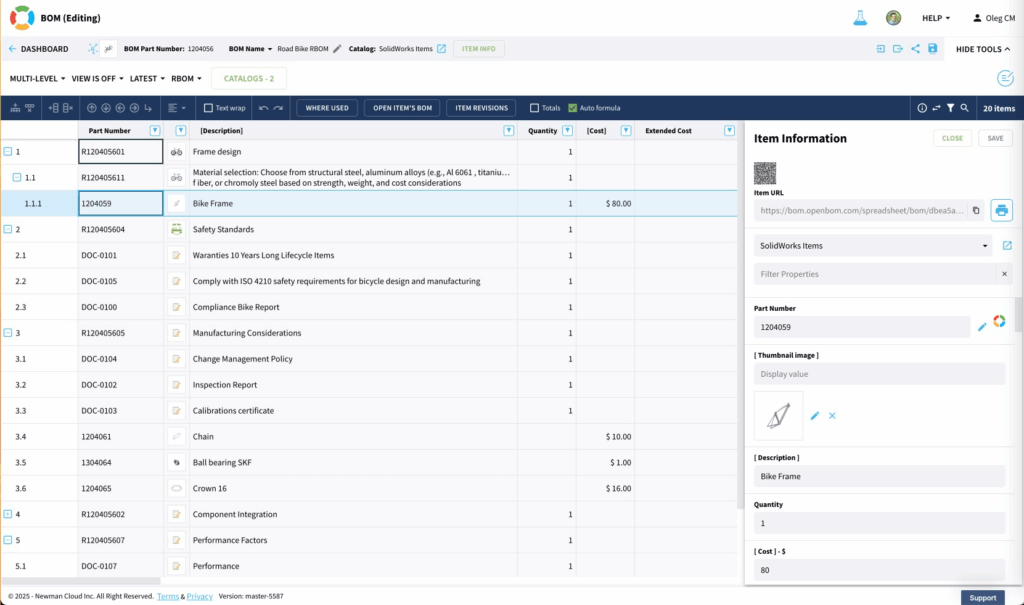
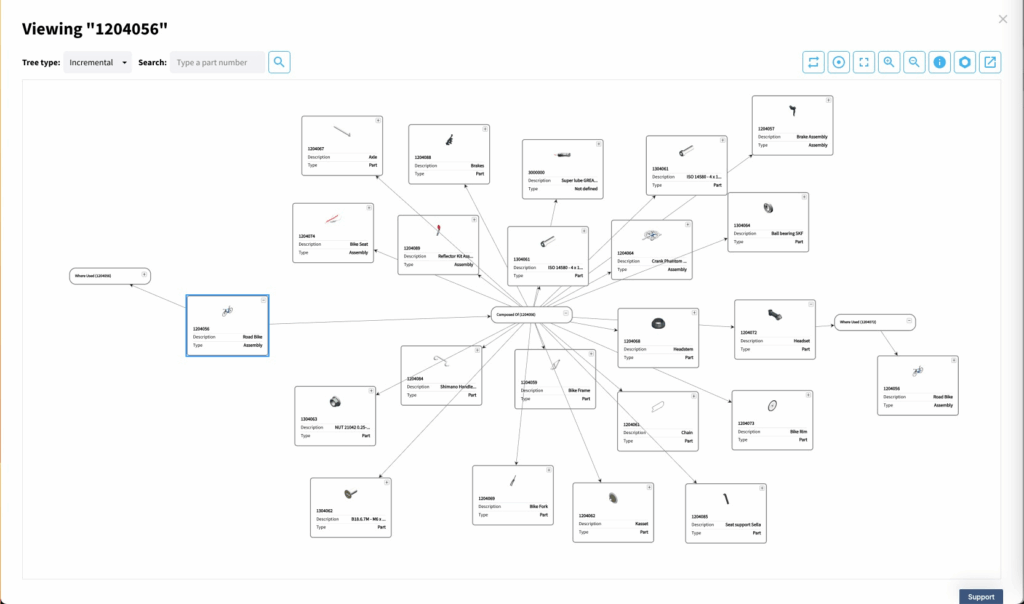
🎥 Video: See How It Works in Real Life
In the following video you can watch how OpenBOM organizes multiple BOMs using xBOM model and connects them all in a digital thread – Requirement management, Engineering, Manufacturing, Serial, Maintenance.
In this short walkthrough, we show you how a single requirement flows through the digital thread, from capture, to validation, to sourcing, to final service. You’ll see how changes ripple through and how everyone from design to support stays in the loop.
Tracing the Journey: From Requirements to Maintenance
Here’s the beauty of xBOM and OpenBOM’s product graph for requirements management: you can maintain traceability of a requirement through the full lifecycle of a product.
It begins with capturing the requirement in a structured way. Maybe it’s a regulatory standard constraint, a customer spec, or a performance metric. From there, you can link that requirement to specific parts, subassemblies, or even entire BOM views.
As engineering teams make changes, you can validate whether the updated design still satisfies the original requirements. If a requirement is impacted, the system flags it, and you can take action before it becomes a problem.
When it’s time to source components, procurement sees the requirement context. Later, when maintenance teams are replacing a part in the field, they can understand why that part was chosen and whether the replacement still meets the spec.
That’s the promise of successful requirements management using a connected product lifecycle. And it starts with treating requirements like first-class data.
Real-Life Scenario: Keeping Compliance in Check
Let’s say you’re building a medical device, something that needs to pass FDA and ISO standards. You have dozens of material specs, labeling rules, and traceability constraints.
With OpenBOM, you can create each of these compliance requirements as separate objects. Then, link them directly to items in your engineering BOM.
If someone tries to substitute a supplier or revise a part, OpenBOM immediately shows which regulatory requirements are affected. No guesswork. No manual processes. Just clear, connected requirements traceability.
And when the auditor shows up? You’ve got the full digital record at your fingertips.
Why Requirements, Quality, and Change Belong Together
Engineering changes are inevitable. What matters is how you establish change management.
In OpenBOM, requirements don’t just sit in the background – they’re part of the change process. You can tie a requirement to a specific proposed change request and validate it as part of your release workflow.
If you’re managing to ISO 9001 or other quality standards, this requirements management software integration is a lifesaver. It gives you audit trails, requirements management workflow, and impact analysis – all within the same system.
For a deeper dive, check out our blog: The Critical Role of Quality Standards in Manufacturing Success
Collaboration Without Chaos
Requirements don’t live in a vacuum. Engineers, software development teams, project managers, quality managers, procurement leads, and service teams all need to access, understand, and sometimes update them throughout the project lifecycle.
With OpenBOM, collaboration is built in. Everyone works on the same digital thread, with role-based access, version control, and real-time updates. No more sending out PDFs or waiting for “the latest spreadsheet.”
When requirements are part of your product graph, everyone sees the same truth – no matter their role.
Getting Started with Requirements in OpenBOM
Ready to make requirements part of your digital thread? Start simple.
You can define a requirement as a custom object, just like a part or design document. From there, connect it to the relevant items in your BOM. Add properties like requirement type, source, owner, and verification and validation status.
Once you’ve got that, you’re off and running. As you build out more xBOM views, your requirements can live across engineering, manufacturing, and service without duplication.
If you’re working with suppliers, you’ll also want to read: How to Define Product Requirements for Your Supplier
Final Thoughts: Making Requirements Work for You
Requirements aren’t just a checkbox. They’re a foundation. And when connected properly, they can guide better designs and project objectives, smarter sourcing, smoother audits, and more reliable products.
OpenBOM’s xBOM service doesn’t just help you manage requirements – it helps you live them across every phase of the product lifecycle.
So if you’re tired of treating requirements like forgotten footnotes, give them a home in your product graph. The payoff is clarity, control, and confidence – from concept to customer support.
FAQ
Can OpenBOM import existing requirements from other tools?
Yes, importing from spreadsheets or via API is supported. You can then link those requirements to items and BOMs.
Can I track the history of a requirement?
Absolutely. All requirements, like other OpenBOM objects, are fully versioned and auditable.
What makes OpenBOM’s approach different from traditional RM systems?
Rather than managing requirements in isolation, OpenBOM embeds them directly into your product structures, changes, and processes. It’s part of a single graph – not a separate module.
Can I share requirements with suppliers or contractors?
Yes. OpenBOM supports controlled sharing with external partners, so they can see and validate only what’s relevant to them.
REGISTER FOR FREE to check how OpenBOM can help.
Best, Oleg
Join our newsletter to receive a weekly portion of news, articles, and tips about OpenBOM and our community.


